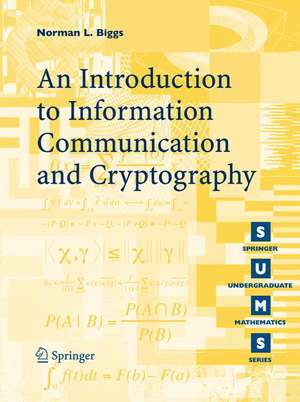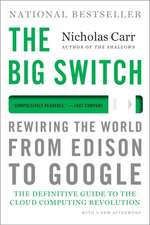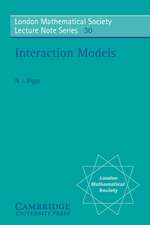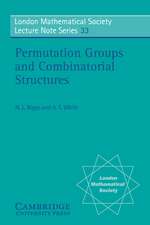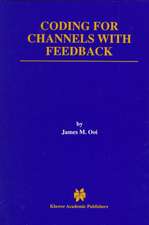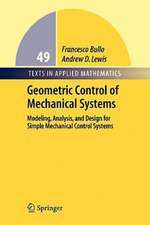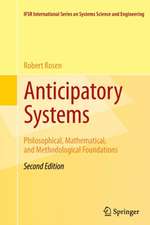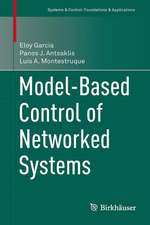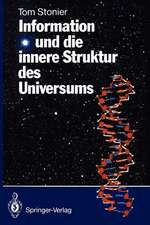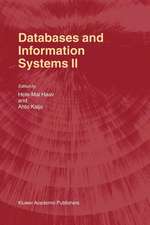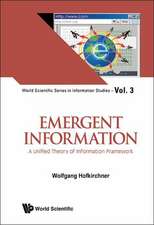Codes: An Introduction to Information Communication and Cryptography: Springer Undergraduate Mathematics Series
Autor Norman L. Biggsen Limba Engleză Paperback – 25 aug 2008
Din seria Springer Undergraduate Mathematics Series
-
 Preț: 319.90 lei
Preț: 319.90 lei -
 Preț: 237.41 lei
Preț: 237.41 lei -
 Preț: 319.02 lei
Preț: 319.02 lei -
 Preț: 325.20 lei
Preț: 325.20 lei -
 Preț: 238.28 lei
Preț: 238.28 lei -
 Preț: 237.29 lei
Preț: 237.29 lei -
 Preț: 265.92 lei
Preț: 265.92 lei -
 Preț: 236.87 lei
Preț: 236.87 lei -
 Preț: 236.97 lei
Preț: 236.97 lei -
 Preț: 240.63 lei
Preț: 240.63 lei -
 Preț: 237.18 lei
Preț: 237.18 lei -
 Preț: 283.11 lei
Preț: 283.11 lei -
 Preț: 359.15 lei
Preț: 359.15 lei -
 Preț: 358.55 lei
Preț: 358.55 lei -
 Preț: 221.92 lei
Preț: 221.92 lei -
 Preț: 224.54 lei
Preț: 224.54 lei -
 Preț: 358.82 lei
Preț: 358.82 lei -
 Preț: 301.10 lei
Preț: 301.10 lei -
 Preț: 383.17 lei
Preț: 383.17 lei -
 Preț: 229.86 lei
Preț: 229.86 lei -
 Preț: 268.37 lei
Preț: 268.37 lei -
 Preț: 166.75 lei
Preț: 166.75 lei -
 Preț: 239.86 lei
Preț: 239.86 lei -
 Preț: 266.70 lei
Preț: 266.70 lei -
 Preț: 269.99 lei
Preț: 269.99 lei - 15%
 Preț: 526.67 lei
Preț: 526.67 lei -
 Preț: 320.20 lei
Preț: 320.20 lei -
 Preț: 272.69 lei
Preț: 272.69 lei -
 Preț: 258.88 lei
Preț: 258.88 lei -
 Preț: 265.83 lei
Preț: 265.83 lei -
 Preț: 265.18 lei
Preț: 265.18 lei -
 Preț: 275.36 lei
Preț: 275.36 lei -
 Preț: 278.24 lei
Preț: 278.24 lei -
 Preț: 266.70 lei
Preț: 266.70 lei -
 Preț: 275.74 lei
Preț: 275.74 lei -
 Preț: 328.08 lei
Preț: 328.08 lei -
 Preț: 265.78 lei
Preț: 265.78 lei -
 Preț: 275.74 lei
Preț: 275.74 lei -
 Preț: 273.45 lei
Preț: 273.45 lei -
 Preț: 277.32 lei
Preț: 277.32 lei -
 Preț: 270.57 lei
Preț: 270.57 lei -
 Preț: 273.63 lei
Preț: 273.63 lei -
 Preț: 270.19 lei
Preț: 270.19 lei -
 Preț: 265.36 lei
Preț: 265.36 lei -
 Preț: 265.36 lei
Preț: 265.36 lei -
 Preț: 268.08 lei
Preț: 268.08 lei -
 Preț: 272.86 lei
Preț: 272.86 lei -
 Preț: 272.69 lei
Preț: 272.69 lei -
 Preț: 271.16 lei
Preț: 271.16 lei
Preț: 272.49 lei
Nou
Puncte Express: 409
Preț estimativ în valută:
52.16€ • 56.67$ • 43.84£
52.16€ • 56.67$ • 43.84£
Carte tipărită la comandă
Livrare economică 21 aprilie-05 mai
Preluare comenzi: 021 569.72.76
Specificații
ISBN-13: 9781848002722
ISBN-10: 1848002726
Pagini: 284
Ilustrații: X, 274 p. 36 illus.
Dimensiuni: 178 x 235 x 16 mm
Greutate: 0.48 kg
Ediția:2008
Editura: SPRINGER LONDON
Colecția Springer
Seria Springer Undergraduate Mathematics Series
Locul publicării:London, United Kingdom
ISBN-10: 1848002726
Pagini: 284
Ilustrații: X, 274 p. 36 illus.
Dimensiuni: 178 x 235 x 16 mm
Greutate: 0.48 kg
Ediția:2008
Editura: SPRINGER LONDON
Colecția Springer
Seria Springer Undergraduate Mathematics Series
Locul publicării:London, United Kingdom
Public țintă
ResearchCuprins
Coding and its uses.- Prefix free codes.- Economical coding.- Data compression.- Noisy channels.- The problem of reliable communication.- The noisy coding theorems.- Linear codes.- Algebraic coding theory.- Coding natural languages.- The development of cryptography.- Cryptography in theory and practice.- The RSA cryptosystem.- Cryptography and calculation.- Elliptic curve cryptography.
Recenzii
From the reviews:
"This undergraduate textbook is a pleasure to read. … The author has a sense of humor, and he is not afraid to use it. The examples are very well chosen. … This very enjoyable book deserves many readers." (Miklós Bóna, The Mathematical Association of America, September, 2008)
"This is a clearly and carefully written introduction into information theory, coding theory and cryptography. … Due to the many motivating explanation, the numerous number of examples (for nearly every definition, concept and result) … and the many suggestions for further reading this book is, in my opinion, very suitable as well as for beginners in the field … . I can very much recommend this book to interested bachelor students as well as to lecturers on this subject." (Ralph-Hardo Schulz, Zentralblatt MATH, Vol. 1148, 2008)
"Coding here refers to the formal transcription of abstract information with the aim of achieving some combination of efficiency, reliability, and perhaps security. … Codes provides the student an initiation and shows the author’s great talent for mathematical exposition clearly propelled by big ideas. … will be valuable for academic libraries. Summing Up: Highly recommended. Advanced academic audiences, upper-division undergraduates through researchers/faculty." (D. V. Feldman, Choice, Vol. 46 (8), April, 2009)
"There are indeed substantial texts devoted to compression, coding systems of various sorts, and encryption. This text brings these three components together in a unified context and provides a basic, mathematically inclined introduction to each. … There is a reasonable amount of worked examples and exercises in the text. … This book could serve as a nice introduction to coding theory for computer science or electrical engineering students … and for mathematics students interested in computing and applied mathematics." (Jeffrey Putnam, ACM Computing Reviews, September, 2009)
"This undergraduate textbook is a pleasure to read. … The author has a sense of humor, and he is not afraid to use it. The examples are very well chosen. … This very enjoyable book deserves many readers." (Miklós Bóna, The Mathematical Association of America, September, 2008)
"This is a clearly and carefully written introduction into information theory, coding theory and cryptography. … Due to the many motivating explanation, the numerous number of examples (for nearly every definition, concept and result) … and the many suggestions for further reading this book is, in my opinion, very suitable as well as for beginners in the field … . I can very much recommend this book to interested bachelor students as well as to lecturers on this subject." (Ralph-Hardo Schulz, Zentralblatt MATH, Vol. 1148, 2008)
"Coding here refers to the formal transcription of abstract information with the aim of achieving some combination of efficiency, reliability, and perhaps security. … Codes provides the student an initiation and shows the author’s great talent for mathematical exposition clearly propelled by big ideas. … will be valuable for academic libraries. Summing Up: Highly recommended. Advanced academic audiences, upper-division undergraduates through researchers/faculty." (D. V. Feldman, Choice, Vol. 46 (8), April, 2009)
"There are indeed substantial texts devoted to compression, coding systems of various sorts, and encryption. This text brings these three components together in a unified context and provides a basic, mathematically inclined introduction to each. … There is a reasonable amount of worked examples and exercises in the text. … This book could serve as a nice introduction to coding theory for computer science or electrical engineering students … and for mathematics students interested in computing and applied mathematics." (Jeffrey Putnam, ACM Computing Reviews, September, 2009)
Textul de pe ultima copertă
Information is an important feature of the modern world. Mathematical techniques underlie the devices that we use to handle it, for example, mobile phones, digital cameras, and personal computers.
This book is an integrated introduction to the mathematics of coding, that is, replacing information expressed in symbols, such as a natural language or a sequence of bits, by another message using (possibly) different symbols. There are three main reasons for doing this: economy, reliability, and security, and each is covered in detail. Only a modest mathematical background is assumed, the mathematical theory being introduced at a level that enables the basic problems to be stated carefully, but without unnecessary abstraction. Other features include:
This book is an integrated introduction to the mathematics of coding, that is, replacing information expressed in symbols, such as a natural language or a sequence of bits, by another message using (possibly) different symbols. There are three main reasons for doing this: economy, reliability, and security, and each is covered in detail. Only a modest mathematical background is assumed, the mathematical theory being introduced at a level that enables the basic problems to be stated carefully, but without unnecessary abstraction. Other features include:
- clear and careful exposition of fundamental concepts, including optimal coding, data compression, and public-key cryptography;
- concise but complete proofs of results;
- coverage of recent advances of practical interest, for example in encryption standards, authentication schemes, and elliptic curve cryptography;
- numerous examples and exercises, and a full solutions manual available to lecturers from www.springer.com
Caracteristici
By the author of the highly-praised text Discrete Mathematics Introduces the mathematical theories that find many applications in modern technology, bringing readers up-to-date with topics of great current interest, both in practice and in theory Clear and concise, with complete proofs of the results and a wealth of examples and exercises to test understanding Assumes only a modest mathematical background and provides careful explanations of the basic principles without recourse to jargon Includes supplementary material: sn.pub/extras Request lecturer material: sn.pub/lecturer-material
